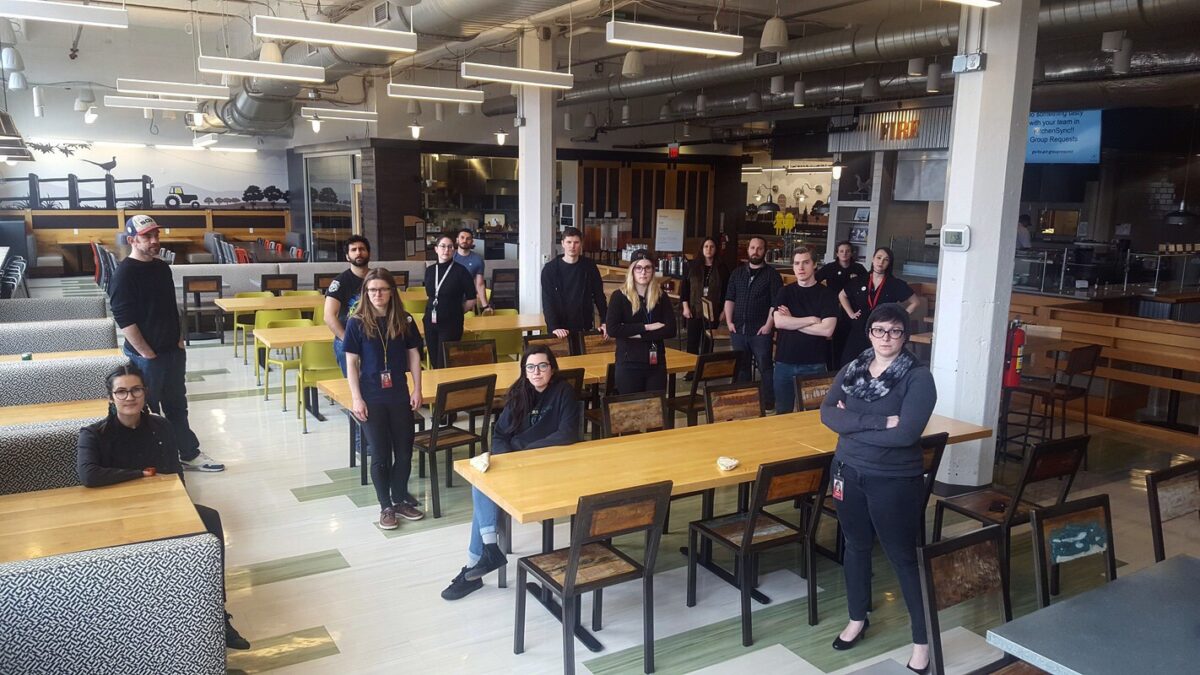As Pittsburgh grows into a technology hub, it’s no surprise that its labor movement has developed in parallel.
Pittsburgh is after all a union town — even if its unions look drastically different from how they used to. Once ruled by steel and coal, the top employers today fall into the education, healthcare and computer science categories.
Pittsburgh’s unionization rate is about 14%, considerably higher than the national average of 10%. The total rate of union membership in the US dropped between 2020 and 2023. In that same period Pittsburgh’s own United Steelworkers (USW) reportedly grew its membership in Pennsylvania by 20% .
The tech organizing movement in Pittsburgh is young, but it draws strength from its city’s union legacy and seasoned activists.
Sadly even here, tech and labor organizing don’t intersect all that often. According to the Bureau of Labor Statistics, unions represented just 4.7% of computer and mathematical occupations nationally in 2023, a category that includes jobs in data processing, software development and more.
In many cases, this isn’t for lack of trying. Tesla fired dozens of software workers from its Autopilot department days after their unionization campaign was announced in 2023, and earlier this year Google abruptly laid off a group of subcontractors at YouTube Music after they unionized.
The tech organizing movement in Pittsburgh is young, but it draws strength from its city’s union legacy and seasoned activists. I know that because over the last five years, I’ve lived it.
Applying the USW ethos to our data analyst jobs
In 2019, IT services company HCL hired me to work as a data analyst at Google’s Pittsburgh office. Having just graduated college with what felt like a virtually useless degree in linguistics, I couldn’t believe I was being given such a promising opportunity.
HCL is one of many companies that provide subcontractors to Google, forming a “shadow workforce” that keeps things running behind the scenes without directly working for Google. Temps, contractors and vendors like us were to leave as little of a trace of our presence in the office as possible, even though many of us worked closely with full-time Googlers.
Subcontractors are attractive to tech companies like Google because we can get the job done for much cheaper than traditional workers. Employers save big by cutting costs like unemployment and health insurance. With a two-tier workforce, employers can emphasize the generous compensation awarded to the minority of permanent employees.
I saw this principle in action when I reluctantly accepted my company’s non-negotiable starting salary offer of $40,000. That works out to $19.53 per hour, just below California’s new $20 minimum wage for fast-food employees.
It was a liveable wage in Pittsburgh for this childless, debt-free adult, but it certainly wasn’t the high-rolling salary one might expect from a pivot to tech. (Of course, many of the people who make the work I do possible – data labelers, IT specialists, and the like – are paid much less.)
Despite the unimpressive pay, however, I was relieved to find a job with benefits. Even before our union drive, we at least had adequate health insurance, retirement plans and 12 company holidays.
My new coworkers were great, the work was tolerable and the in-office perks lived up to the hype. However, it would quickly become impossible for me to ignore the strange politics of Google’s two-tier system.

Code for America just ratified its first union contract
Inked in 2023, the org’s first collective bargaining agreement includes wage increases, paid family leave, adoption and fertility support and gender-affirming care..
Just a few weeks after I started, my new coworkers approached me about a secret union drive which was then in its early stages. I’ll admit I was a little taken aback at the idea of a labor union made up entirely of data analysts.
The unions I was familiar with were in dangerous steel mills and coal mines and were preoccupied with avoiding workplace injury. Drinking my free latte in one of Google’s manicured “micro-kitchens,” unionization seemed like an absurd proposal.
I was even more surprised that my colleagues were planning to organize with the USW. They explained that since the Steel Crisis devastated Pittsburgh’s industry in the 1970s and 80s, USW diversified to represent a variety of industries, but it still felt strange.
The union offered a chance to make my voice heard at the workplace, and the promise of a pay bump didn’t hurt. I was in.
In April, Google rolled back its policies requiring staffing agencies to provide their employees health insurance and a $15 minimum wage.
In September 2019, my colleagues and I voted to organize with the USW by a two-thirds majority. Over the next two years, they worked tirelessly to nearly triple our average annual raises and secure a minimum headcount to prevent our jobs from being offshored. The union also won us paid holidays on President’s Day and Martin Luther King Jr. Day. Google’s offices are closed on those days but HCL refused to recognize them as holidays before, forcing us to use our own PTO to stay home from work.
In July 2021, we finally ratified our first contract, outlining mutually agreed-upon working conditions between HCL and the union.
Tech unionization isn’t so different from other sectors
Since 2019 my local union has grown to welcome more than 300 employees at the Carnegie Library of Pittsburgh, over 500 employees at the Carnegie Museums and others, in addition to my own unit.
The jobs of a librarian, a gallery technician and a data analyst are quite different. One thing we share is the experience of working at one of Pittsburgh’s cultural touchstones.
The Carnegie empire shaped Pittsburgh’s history and identity through the 20th century. Meanwhile, the opening of Google’s new East Liberty office in 2010 was a pivotal point in the city’s tech renaissance.
Awareness of this history helps us feel grounded in the community and stay motivated to fight for it. With its own extensive legacy in this city, the USW was the natural choice to represent our group.
However, the landscape for Google contractors has shifted since then.
In April, Google rolled back its policies requiring staffing agencies to provide their employees health insurance and a $15 minimum wage.
Incoming temps, vendors and contractors will no longer be guaranteed the benefits I got years ago — and existing workers without a union contract could even lose theirs.
Independent contractors can theoretically negotiate their compensation without union protection. That privilege is one reason more and more tech workers are transitioning to the gig economy, which companies have likewise come to rely on.
But while some contractors can make more money upfront than permanent employees, many end up sacrificing luxuries like health insurance and paid leave.
Meanwhile, full-time employees face stagnating wages and layoffs en masse.
For me, the union is primarily a way to help shape the future of a profession I’m passionate about and a city I love, though it’s not a foolproof system. In a way it’s like contracting taken to its logical extreme: We still have to fight to get what we deserve, but rather than playing against management solo, we get to pool our chips together at the bargaining table.
Before you go...
Please consider supporting Technical.ly to keep our independent journalism strong. Unlike most business-focused media outlets, we don’t have a paywall. Instead, we count on your personal and organizational support.
3 ways to support our work:- Contribute to the Journalism Fund. Charitable giving ensures our information remains free and accessible for residents to discover workforce programs and entrepreneurship pathways. This includes philanthropic grants and individual tax-deductible donations from readers like you.
- Use our Preferred Partners. Our directory of vetted providers offers high-quality recommendations for services our readers need, and each referral supports our journalism.
- Use our services. If you need entrepreneurs and tech leaders to buy your services, are seeking technologists to hire or want more professionals to know about your ecosystem, Technical.ly has the biggest and most engaged audience in the mid-Atlantic. We help companies tell their stories and answer big questions to meet and serve our community.
Join our growing Slack community
Join 5,000 tech professionals and entrepreneurs in our community Slack today!

The person charged in the UnitedHealthcare CEO shooting had a ton of tech connections

From rejection to innovation: How I built a tool to beat AI hiring algorithms at their own game

Where are the country’s most vibrant tech and startup communities?




